Exploring the Impact of Surface Thermal Treatments on WC-Co Blocks Subjected to Linear Scratching: A Molecular Dynamics Simulation Study
Abstract
:1. Introduction
2. Materials and Methods
2.1. Conformations
2.2. Interatomic Potential Model: Alaytic Bond Order Potential (ABOP) Model
2.3. Simulation Protocols
2.4. Local Entropy and Von Mises Stress
3. Results and Discussions
3.1. Validation of ABOP Model
3.2. Structural and Mechanial Characteristics Variations Subject to Linear Scratch
3.3. Bivariate Histograms Under Linear Scratching Processes
4. Conclusions
- The results demonstrate that high energy flux markedly enhances cobalt evaporation rates, with the extent of evaporation being strongly influenced by the energy flux and the local atomic environment. Cobalt atoms embedded within WC grains exhibit increased resistance to evaporation due to stronger bonding interactions, whereas pure cobalt surfaces are more susceptible to material loss. At elevated energy flux levels, WC-Co surfaces experience a complex interplay of density reduction, thermal expansion, and evaporation processes, leading to accelerated material degradation compared to pure cobalt surfaces.
- Linear scratching simulations reveal that thermally treated WC and WC-Co surfaces exhibit heightened structural instability. This instability is evidenced by broader distributions of local entropy and von Mises stress, indicating an increased susceptibility to deformation and potential failure. The stress concentrations induced by indentation and scratching are more pronounced in thermally treated materials, underscoring the significant impact of thermal history on their mechanical behavior.
- The utilization of molecular dynamics simulations has proven invaluable in capturing atomic-scale phenomena that are challenging to observe experimentally. This approach allowed for precise quantification of the effects of energy flux, material composition, and thermal history on the structural and mechanical responses of WC-Co composites. The detailed insights gained into the mechanisms driving the observed changes enhance the fundamental understanding of high-energy thermal treatments on these materials.
- The findings underscore the importance of optimizing energy flux and thermal treatment protocols to mitigate material degradation and improve the durability of WC-Co-based components. By analyzing the nanoscale interactions and transformations induced by electron beam irradiation, this study provides guidance for the development of more robust and reliable tools and coatings for industrial applications.
Author Contributions
Funding
Institutional Review Board Statement
Informed Consent Statement
Data Availability Statement
Conflicts of Interest
References
- Rotshtein, V.P.; Shulov, V.A. Surface Modification and Alloying of Aluminum and Titanium Alloys with Low-Energy, High-Current Electron Beams. J. Metall. 2011, 2011, 1–15. [Google Scholar] [CrossRef]
- Xu, Y.; Zhang, Y.; Hao, S.Z.; Perroud, O.; Li, M.C.; Wang, H.H.; Grosdidier, T.; Dong, C. Surface Microstructure and Mechanical Property of WC-6% Co Hard Alloy Irradiated by High Current Pulsed Electron Beam. Appl. Surf. Sci. 2013, 279, 137–141. [Google Scholar] [CrossRef]
- Li, Y.; Zhou, Z.; Yi, X.; Yan, J.; Xiu, J.; Fang, D.; Shao, M.; Ren, P.; He, Y.; Qiu, J. Improved Seawater Corrosion Resistance of Electron Beam Melting Ti6Al4V Titanium Alloy by Plasma Nitriding. Vacuum 2023, 216, 112463. [Google Scholar] [CrossRef]
- Valkov, S.; Ormanova, M.; Petrov, P. Electron-Beam Surface Treatment of Metals and Alloys: Techniques and Trends. Metals 2020, 10, 1219. [Google Scholar] [CrossRef]
- Zhai, W.; Bai, L.; Zhou, R.; Fan, X.; Kang, G.; Liu, Y.; Zhou, K. Recent Progress on Wear-Resistant Materials: Designs, Properties, and Applications. Adv. Sci. 2021, 8, 2003739. [Google Scholar] [CrossRef]
- Akyol Voss, S.; Canci Matur, U.; Cimenoglu, H.; Baydogan, N. Swelling Modification by Electron Beam at Chalcopyrite Copper Indium Gallium Diselenium Thin-Film Controlled Optical Features. Curr. Appl. Phys. 2023, 52, 9–23. [Google Scholar] [CrossRef]
- Marshall, J.M.; Giraudel, M. The Role of Tungsten in the Co Binder: Effects on WC Grain Size and Hcp–Fcc Co in the Binder Phase. Int. J. Refract. Met. Hard Mater. 2015, 49, 57–66. [Google Scholar] [CrossRef]
- Katiyar, P.K.; Singh, P.K.; Singh, R.; Kumar, A.L. Modes of Failure of Cemented Tungsten Carbide Tool Bits (WC/Co): A Study of Wear Parts. Int. J. Refract. Met. Hard Mater. 2016, 54, 27–38. [Google Scholar] [CrossRef]
- Chandrashekar, M.; Sreenivasa Prasad, K.V. The Effect of Cobalt on Wear Behavior of Cemented Carbide Cutting Tools for Machining of Titanium Alloy. Mater. Today Proc. 2018, 5, 7678–7684. [Google Scholar] [CrossRef]
- Peng, W.; Hao, S.; Zhao, L.; Li, Z.; Chen, J.; Lan, J.; Wang, X.; Wang, K. Thermal Stability of Modified Surface Microstructure on WC-Co Cemented Carbide after High Current Pulsed Electron Beam Irradiation. J. Alloys Compd. 2020, 829, 154545. [Google Scholar] [CrossRef]
- Wang, M.; Du, L.; Xu, Y.; Zhang, X.; Qi, P.T.; Xu, P.; Peng, W.H. Surface Microstructure Evolution Mechanism of WC-Co Hard Alloy Treated by High Current Pulsed Electron Beam. Vacuum 2022, 202, 111139. [Google Scholar] [CrossRef]
- Xu, M.; Wang, H.; Liu, X.; Lu, H.; Song, X. Microstructural Evolution and Toughening Mechanism of WC-Co Composite Prepared by Amorphous-Crystallization Method. Mater. Res. Lett. 2024, 12, 921–928. [Google Scholar] [CrossRef]
- Csanádi, T.; Vojtko, M.; Dusza, J. Deformation and Fracture of WC Grains and Grain Boundaries in a WC-Co Hardmetal during Microcantilever Bending Tests. Int. J. Refract. Met. Hard Mater. 2020, 87, 105163. [Google Scholar] [CrossRef]
- Peng, W.H.; Hao, S.Z.; Pan, W.T.; Lv, Z.B.; Fang, T.H.; Zhao, L.M. Effects of WC Grain Size on Surface Hardening of WC-10Co Cemented Carbides by Pulsed Electron Beam Irradiation. Vacuum 2023, 207, 111613. [Google Scholar] [CrossRef]
- Agode, K.E.; Wolff, C.; Guven, M.; Nouari, M. Modelling of the Damage Initiation at WC/WC and WC/Co Boundaries in WC-Co Tool Material at the Microstructure Scale: Application to the Tool/Chip Contact. Int. J. Refract. Met. Hard Mater. 2024, 119, 106508. [Google Scholar] [CrossRef]
- Piaggi, P.M.; Valsson, O.; Parrinello, M. Enhancing Entropy and Enthalpy Fluctuations to Drive Crystallization in Atomistic Simulations. Phys. Rev. Lett. 2017, 119, 015701. [Google Scholar] [CrossRef]
- Şopu, D.; Moitzi, F.; Mousseau, N.; Eckert, J. An Atomic-Level Perspective of Shear Band Formation and Interaction in Monolithic Metallic Glasses. Appl. Mater. Today 2020, 21, 100828. [Google Scholar] [CrossRef]
- Kim, D.Y.; Yi, T. Investigation of the Surface Characteristics of WC–Co Structures under Local E-Beam Irradiation via Experiments and Molecular Dynamics Simulations. J. Korean Phys. Soc. 2024, 85, 91–99. [Google Scholar] [CrossRef]
- Chen, C.; Zhao, L.; Liu, Y. Size Effect on the Mechanical Responses of Aluminum Nanoparticles under Indentation: A Molecular Dynamics Study. Tribol. Int. 2023, 177, 107959. [Google Scholar] [CrossRef]
- Ren, Z.; Feng, R.; Cao, H.; Zhou, B.; Li, H.; Lei, C. Wear Mechanism of Diamond-Cutting Tool in Nano-Cutting Polycrystalline γ-TiAl Alloy Based on Molecular Dynamics Simulation. J. Manuf. Process. 2024, 119, 118–129. [Google Scholar] [CrossRef]
- Páll, S.; Abraham, M.J.; Kutzner, C.; Hess, B.; Lindahl, E. Tackling Exascale Software Challenges in Molecular Dynamics Simulations with GROMACS. In Solving Software Challenges for Exascale; Markidis, S., Laure, E., Eds.; Lecture Notes in Computer Science; Springer International Publishing: Cham, Switzerland, 2015; Volume 8759, pp. 3–27. [Google Scholar] [CrossRef]
- Thompson, A.P.; Aktulga, H.M.; Berger, R.; Bolintineanu, D.S.; Brown, W.M.; Crozier, P.S.; In’T Veld, P.J.; Kohlmeyer, A.; Moore, S.G.; Nguyen, T.D.; et al. LAMMPS—A Flexible Simulation Tool for Particle-Based Materials Modeling at the Atomic, Meso, and Continuum Scales. Comput. Phys. Commun. 2022, 271, 108171. [Google Scholar] [CrossRef]
- Xie, H.; Song, X.; Yin, F.; Zhang, Y. Effect of WC/Co Coherency Phase Boundaries on Fracture Toughness of the Nanocrystalline Cemented Carbides. Sci. Rep. 2016, 6, 31047. [Google Scholar] [CrossRef] [PubMed]
- Feng, Q.; Song, X.; Xie, H.; Wang, H.; Liu, X.; Yin, F. Deformation and Plastic Coordination in WC-Co Composite—Molecular Dynamics Simulation of Nanoindentation. Mater. Des. 2017, 120, 193–203. [Google Scholar] [CrossRef]
- Peng, D.; Jin, N.; Leng, E.; Liu, Y.; Ye, J.; Li, P. Could an Amorphous Binder Co Phase Improve the Mechanical Properties of WC–Co? A Study of Molecular Dynamics Simulation. RSC Adv. 2023, 13, 15737–15746. [Google Scholar] [CrossRef]
- Wang, S.; Liu, H.; Cheng, X.; Zong, W. An Insight into the Microstructure Effects on Removal Mechanisms of Cemented Carbide WC-Co via Molecular Dynamics Simulations. Int. J. Refract. Met. Hard Mater. 2025, 126, 106946. [Google Scholar] [CrossRef]
- Erhart, P.; Albe, K. Analytical Potential for Atomistic Simulations of Silicon, Carbon, and Silicon Carbide. Phys. Rev. B 2005, 71, 035211. [Google Scholar] [CrossRef]
- Petisme, M.V.G.; Gren, M.A.; Wahnström, G. Molecular Dynamics Simulation of WC/WC Grain Boundary Sliding Resistance in WC–Co Cemented Carbides at High Temperature. Int. J. Refract. Met. Hard Mater. 2015, 49, 75–80. [Google Scholar] [CrossRef]
- Fang, J.; Liu, X.; Lu, H.; Liu, X.; Song, X. Crystal Defects Responsible for Mechanical Behaviors of a WC–Co Composite at Room and High Temperatures—A Simulation Study. Acta Crystallogr. B Struct. Sci. Cryst. Eng. Mater. 2019, 75, 134–142. [Google Scholar] [CrossRef]
- Kanaya, K.; Okayama, S. Penetration and Energy-Loss Theory of Electrons in Solid Targets. J. Phys. D Appl. Phys. 1972, 5, 43–58. [Google Scholar] [CrossRef]
- Stukowski, A. Visualization and Analysis of Atomistic Simulation Data with OVITO–the Open Visualization Tool. Model. Simul. Mater. Sci. Eng. 2010, 18, 015012. [Google Scholar] [CrossRef]
- Tsai, D.H. The virial theorem and stress calculation in molecular dynamics. J. Chem. Phys. 1979, 70, 1375–1382. [Google Scholar] [CrossRef]
- Zimmerman, J.A.; WebbIII, E.B.; Hoyt, J.J.; Jones, R.E.; Klein, P.A.; Bammann, D.J. Calculation of stress in atomistic simulation. Model. Simul. Mater. Sci. Eng. 2004, 12, S319. [Google Scholar] [CrossRef]
- Shibuta, Y.; Suzuki, T. Melting and Nucleation of Iron Nanoparticles: A Molecular Dynamics Study. Chem. Phys. Lett. 2007, 445, 265–270. [Google Scholar] [CrossRef]
- Hamid, I.; Fang, M.; Duan, H. Molecular Dynamical Simulations of Melting Behaviors of Metal Clusters. AIP Adv. 2015, 5, 047129. [Google Scholar] [CrossRef]
- Abdullah, A.; Shabgard, M.R.; Ivanov, A.; Shervanyi-Tabar, M.T. Effect of Ultrasonic-Assisted EDM on the Surface Integrity of Cemented Tungsten Carbide (WC-Co). Int. J. Adv. Manuf. Technol. 2009, 41, 268–280. [Google Scholar] [CrossRef]

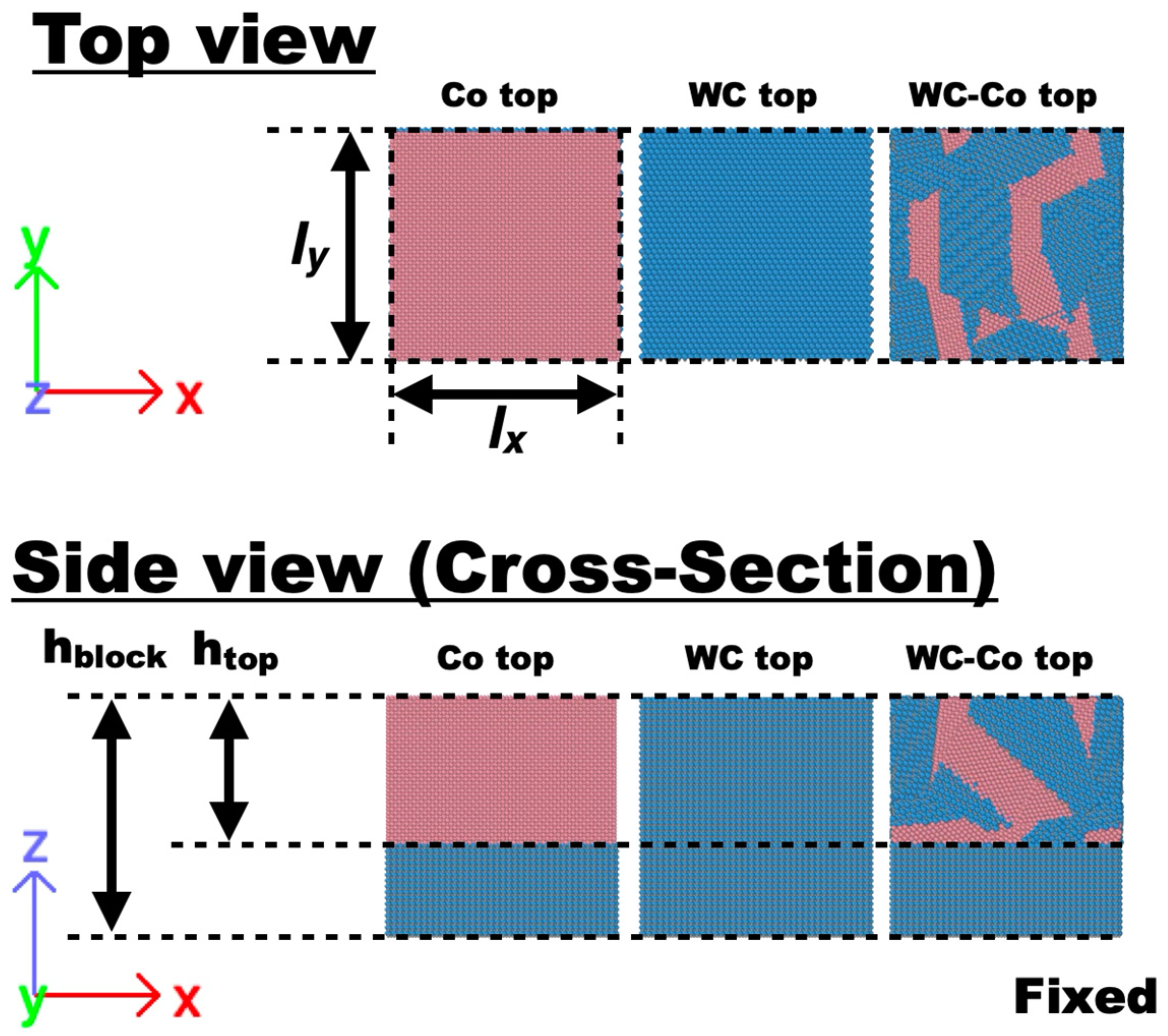
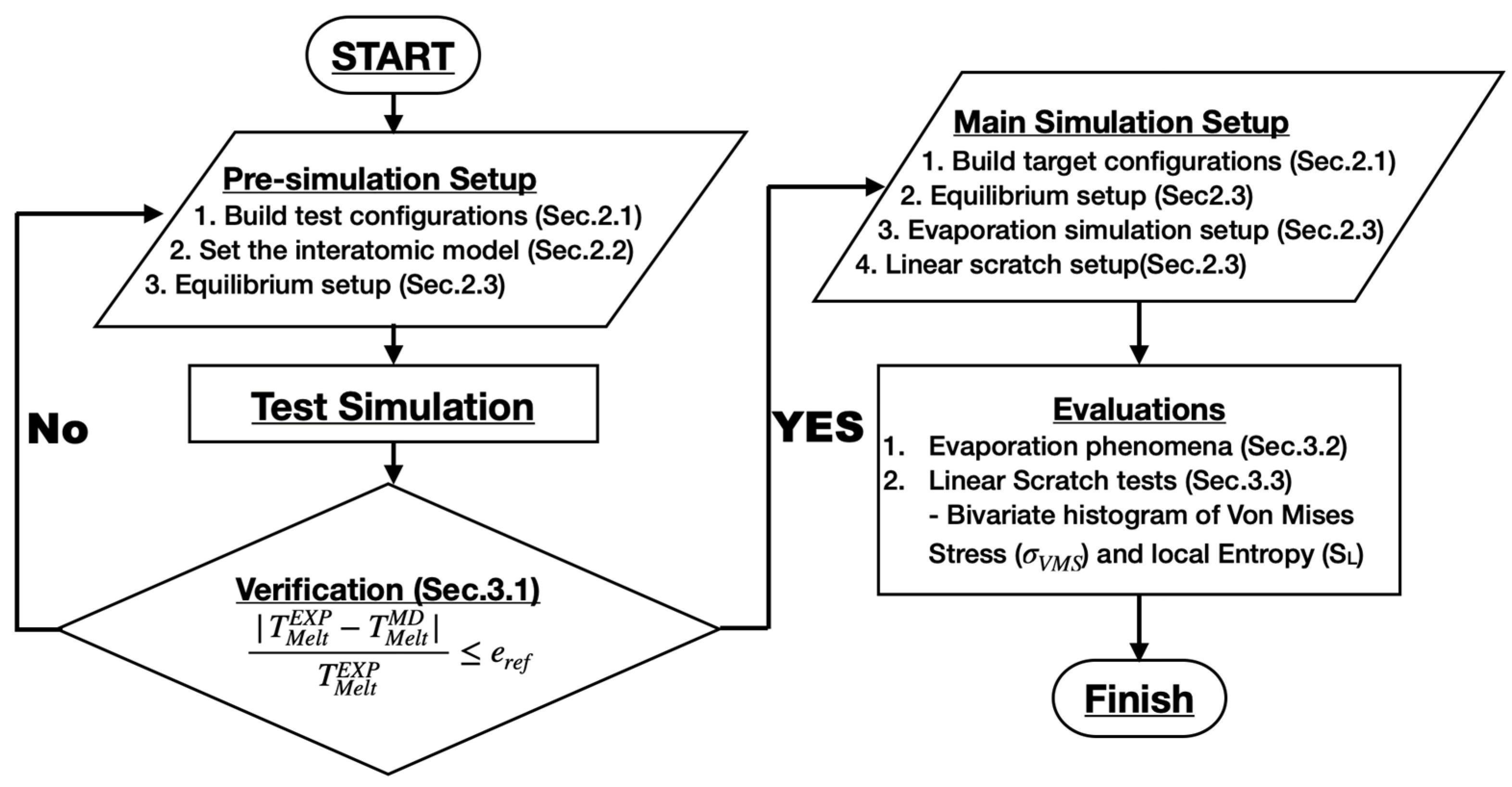
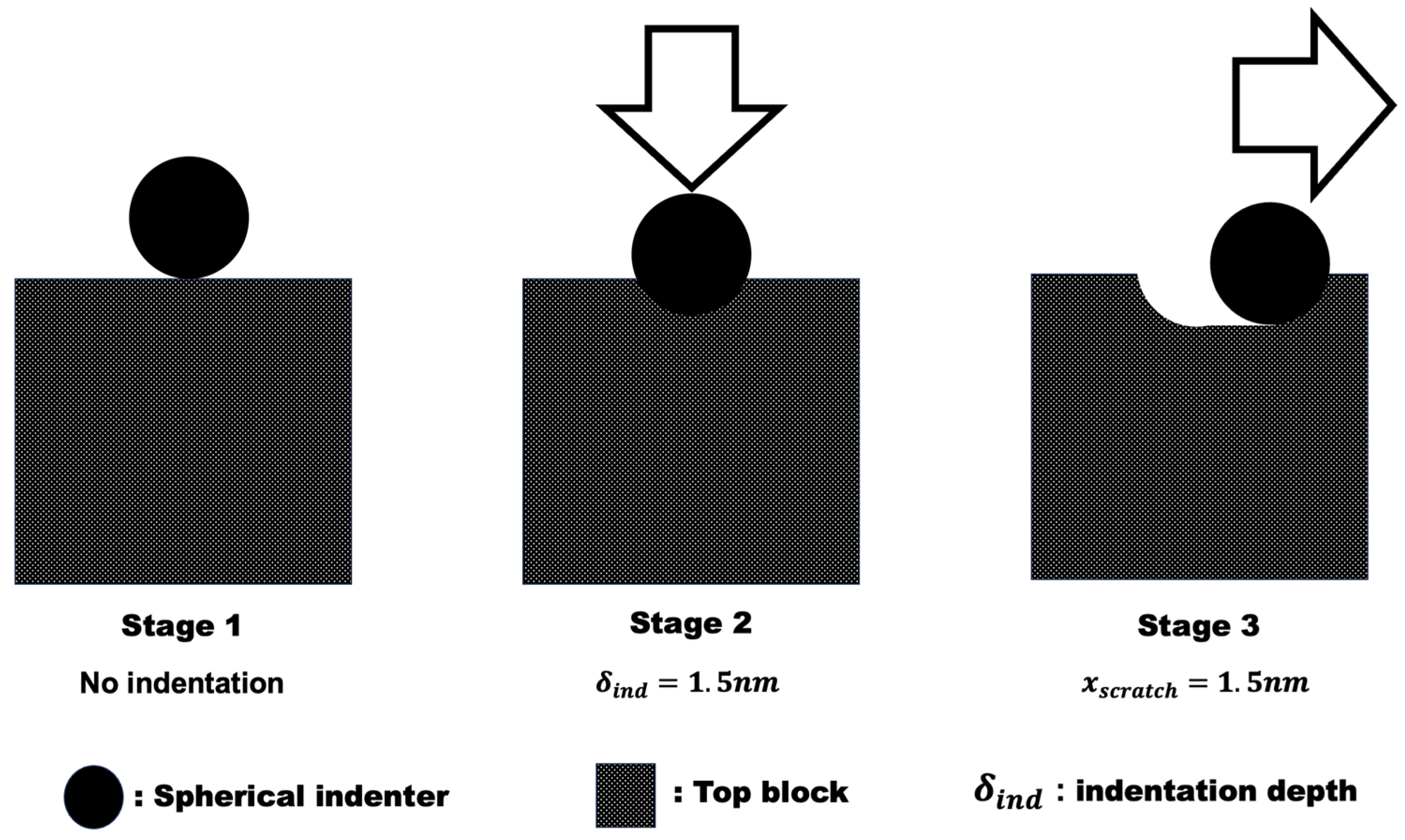

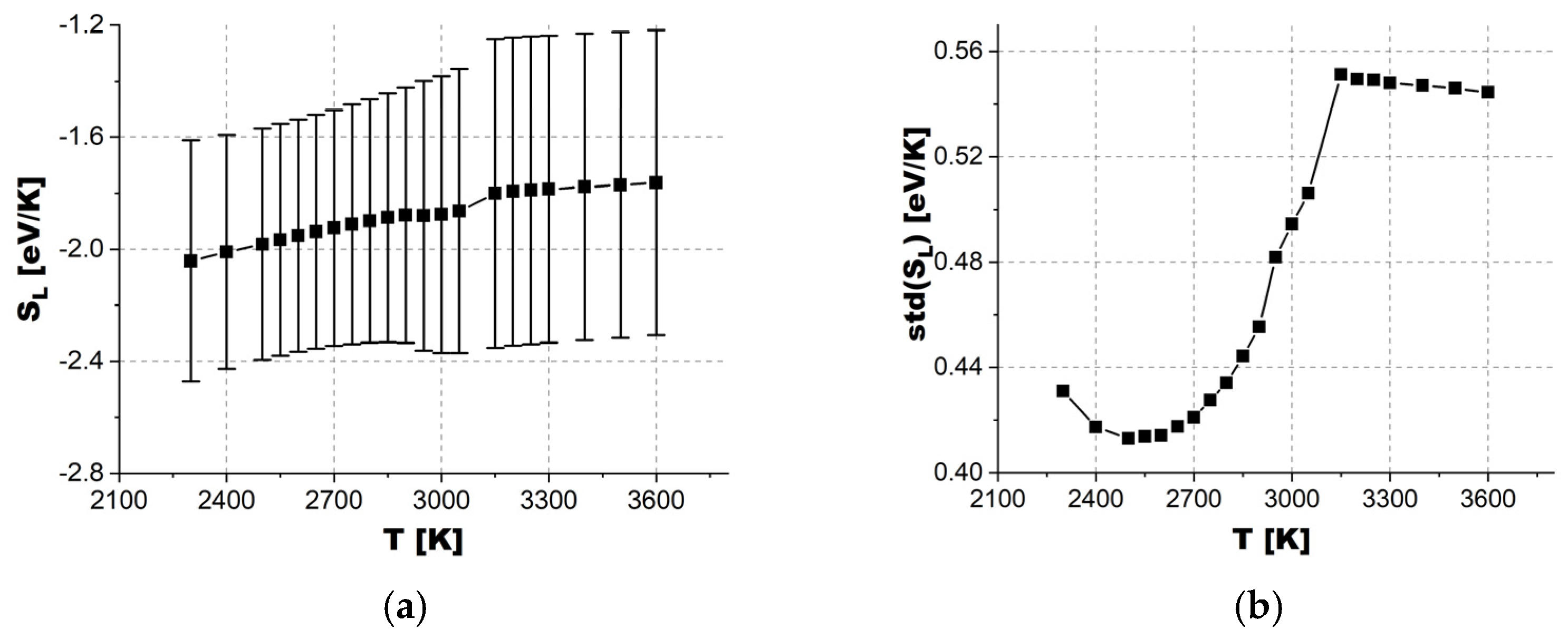
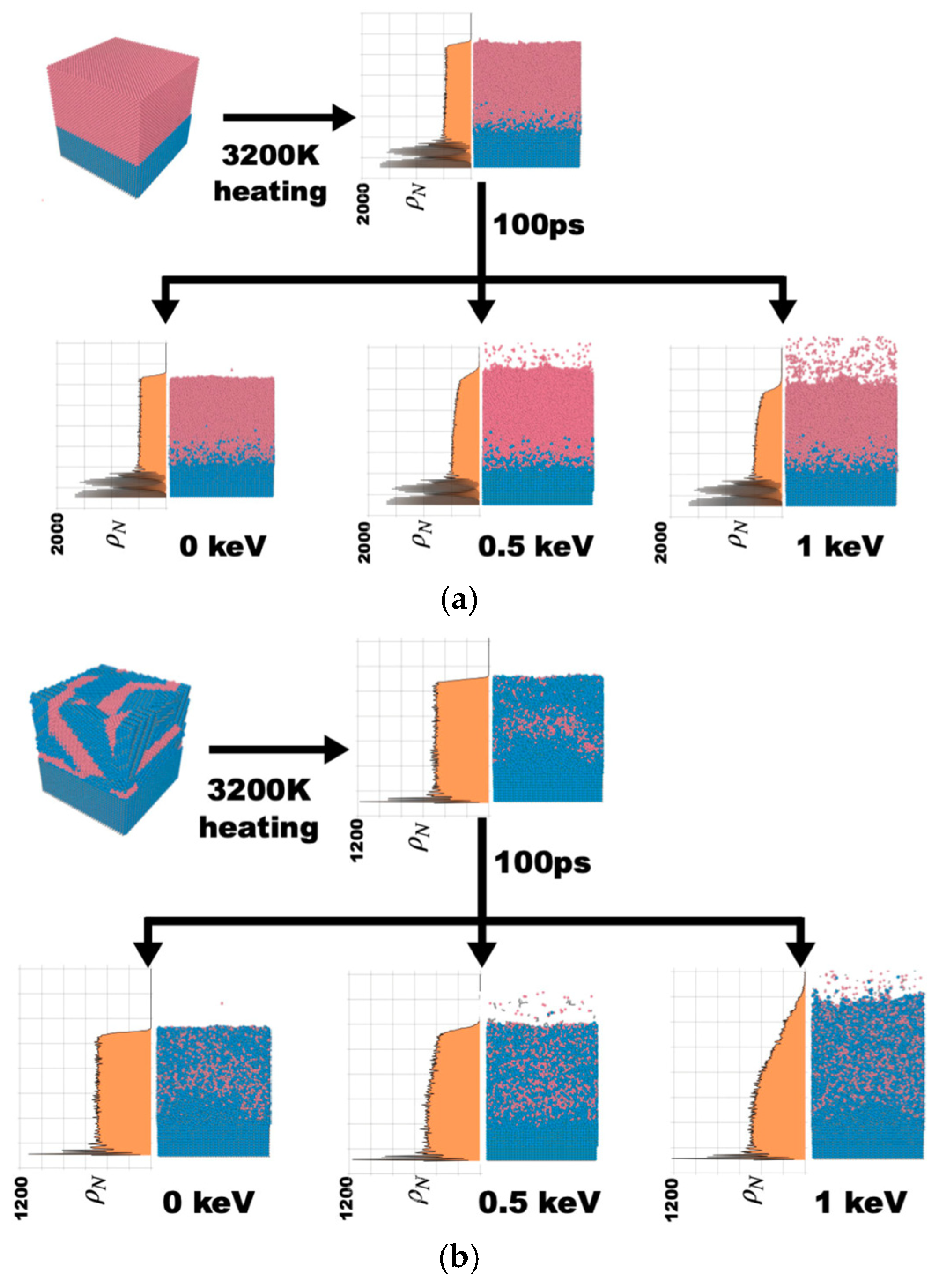
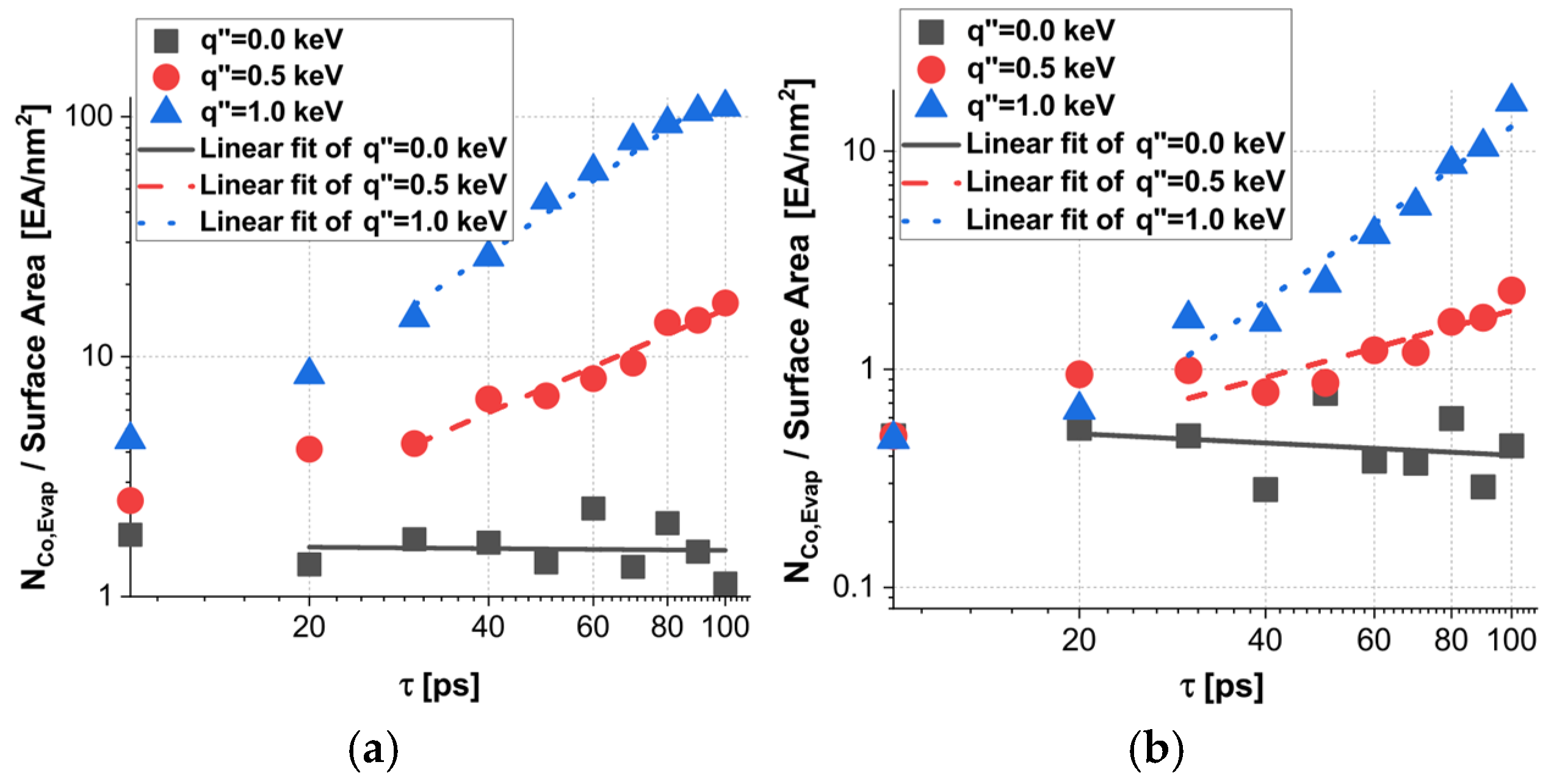
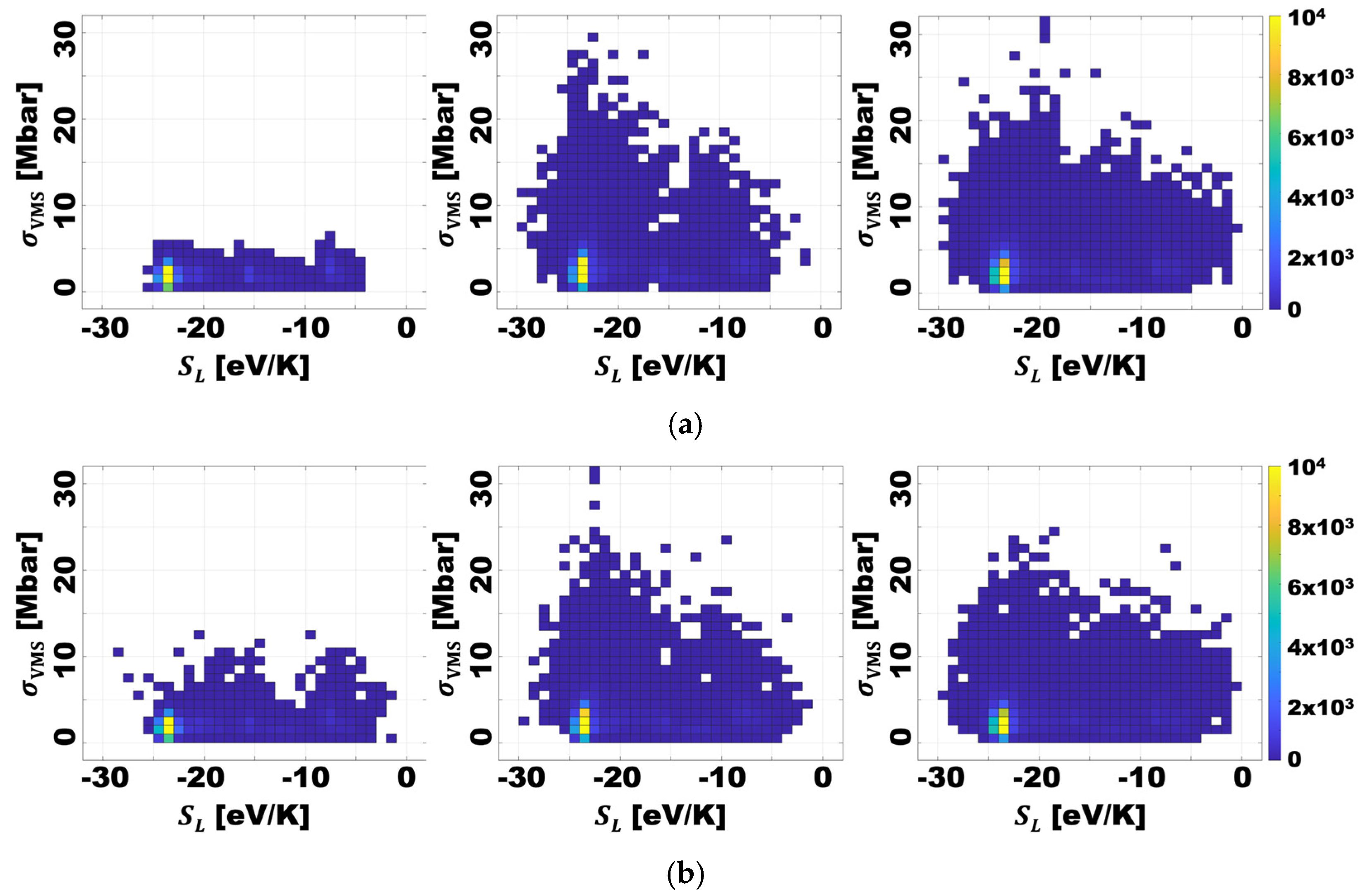
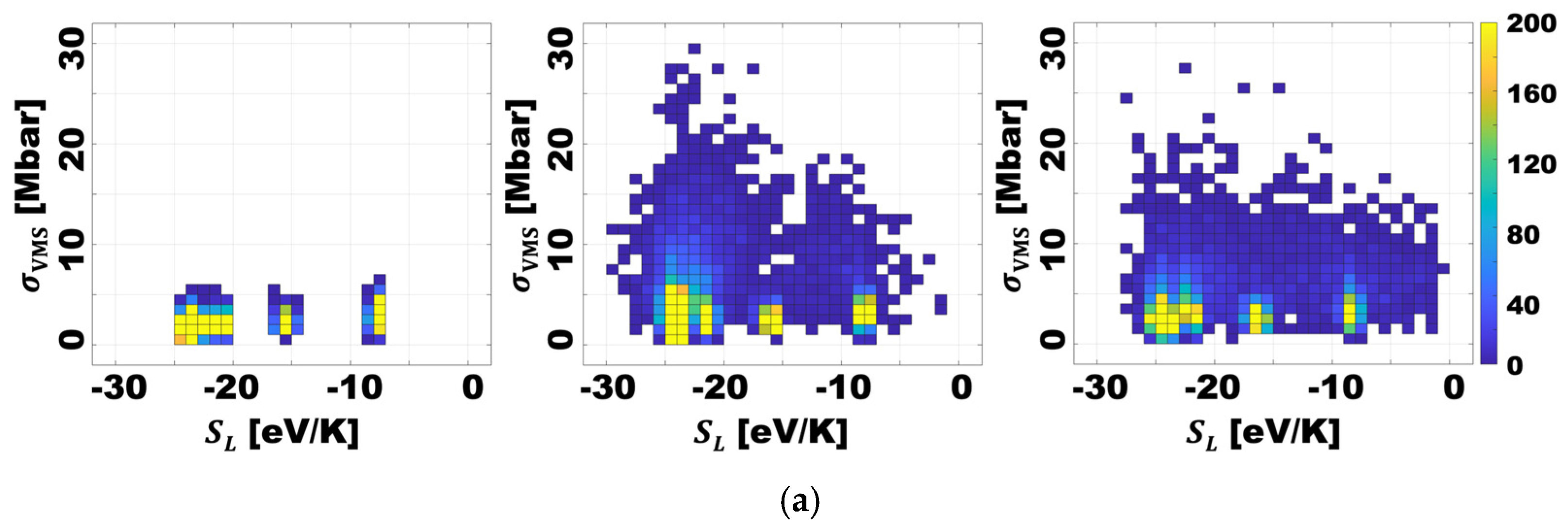


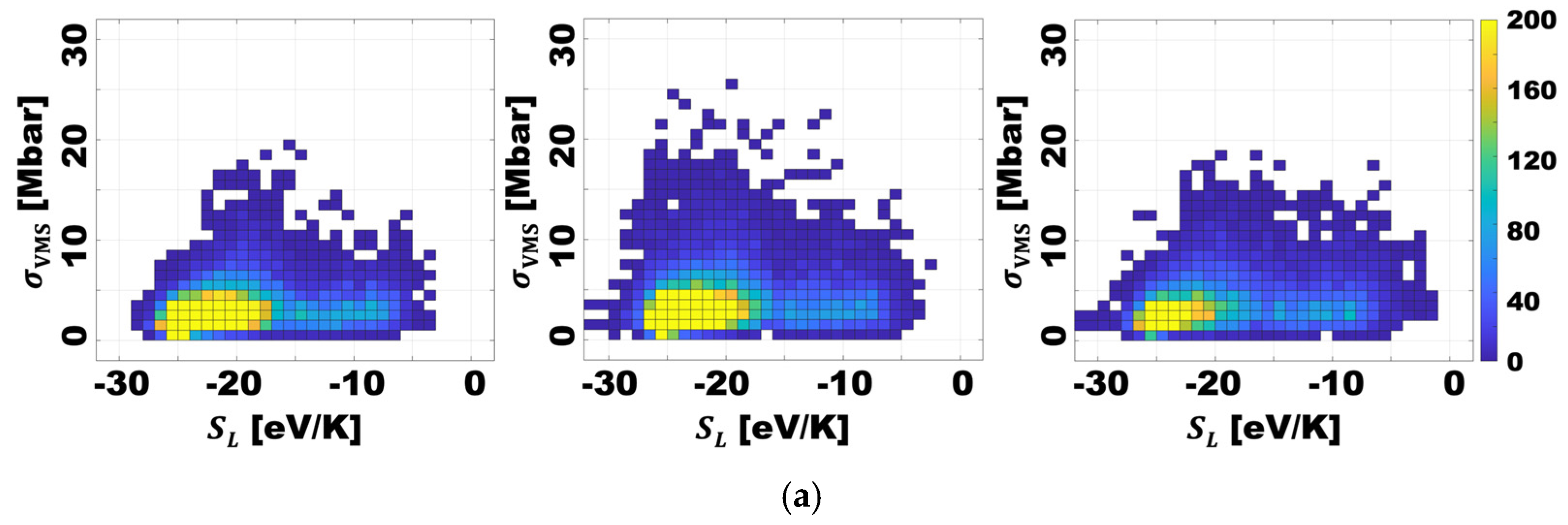
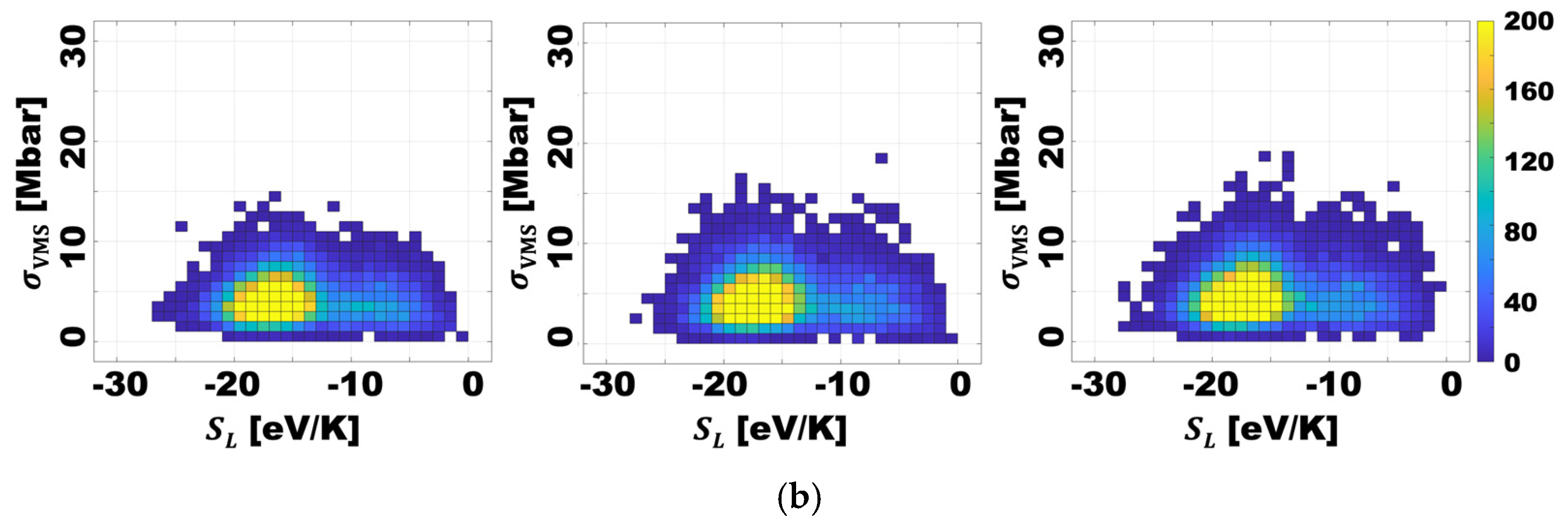
| Variable | Value | Variable | Value |
|---|---|---|---|
| lx | 11.1 nm | htop | 7.0 nm (Co top) 7.1 nm (WC-/WC-Co top) |
| ly | 11.1 nm | hblock | 11.5 nm (Co top) 11.6 nm (WC-/WC-Co top) |
| Power Law Index | q″ | ||
|---|---|---|---|
| 0 keV/ps | 0.5 keV/ps | 1 keV/ps | |
| nCo | −0.22 ±0.16 | 1.08 ± 0.11 | 1.73 ± 0.11 |
| nWC-Co | −0.15 ± 0.22 | 0.77 ± 0.22 | 2.01 ± 0.22 |
Disclaimer/Publisher’s Note: The statements, opinions and data contained in all publications are solely those of the individual author(s) and contributor(s) and not of MDPI and/or the editor(s). MDPI and/or the editor(s) disclaim responsibility for any injury to people or property resulting from any ideas, methods, instructions or products referred to in the content. |
© 2024 by the authors. Licensee MDPI, Basel, Switzerland. This article is an open access article distributed under the terms and conditions of the Creative Commons Attribution (CC BY) license (https://creativecommons.org/licenses/by/4.0/).
Share and Cite
Wang, D.H.; Lee, S.; Yi, T. Exploring the Impact of Surface Thermal Treatments on WC-Co Blocks Subjected to Linear Scratching: A Molecular Dynamics Simulation Study. Coatings 2024, 14, 1576. https://doi.org/10.3390/coatings14121576
Wang DH, Lee S, Yi T. Exploring the Impact of Surface Thermal Treatments on WC-Co Blocks Subjected to Linear Scratching: A Molecular Dynamics Simulation Study. Coatings. 2024; 14(12):1576. https://doi.org/10.3390/coatings14121576
Chicago/Turabian StyleWang, Duck Hyun, Sehan Lee, and Taeil Yi. 2024. "Exploring the Impact of Surface Thermal Treatments on WC-Co Blocks Subjected to Linear Scratching: A Molecular Dynamics Simulation Study" Coatings 14, no. 12: 1576. https://doi.org/10.3390/coatings14121576
APA StyleWang, D. H., Lee, S., & Yi, T. (2024). Exploring the Impact of Surface Thermal Treatments on WC-Co Blocks Subjected to Linear Scratching: A Molecular Dynamics Simulation Study. Coatings, 14(12), 1576. https://doi.org/10.3390/coatings14121576





